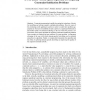1469 search results - page 18 / 294 » Characterizing the Structural Complexity of Real-World Compl... |
NC
2007
13 years 7 months ago
2007
Abstract. We study latching dynamics, i.e. the ability of a network to hop spontaneously from one discrete attractor state to another, which has been proposed as a model of an in´Č...
CSE
2009
IEEE
13 years 11 months ago
2009
IEEE
An important aspect in social computing is the structure of social networks, which build the underlying substrate for the exchange of information. With the growing importance of mi...
ECML
2005
Springer
14 years 1 months ago
2005
Springer
Constraint programming is rapidly becoming the technology of choice for modelling and solving complex combinatorial problems. However, users of this technology need signi´Čücant ex...
BMCBI
2008
13 years 7 months ago
2008
Background: Structure-based computational methods are needed to help identify and characterize protein-protein complexes and their function. For individual proteins, the most succ...
TWC
2010
13 years 2 months ago
2010
It is known that Wideband Code-Division Multiple Access (W-CDMA) networks are limited by interference more than by any other single effect. Due to the frequency selectivity of the ...

